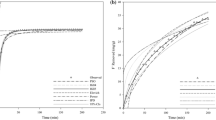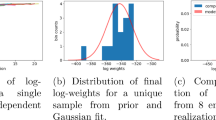Abstract
The ensemble smoother with multiple data assimilation (ES-MDA) coupled to a normal-score transformation is used to fit a Langmuir isotherm curve to estimate its parameters (\(S_{m}\) and b) and their uncertainty. The highlights of this work are threefold: (1) the ES-MDA can be used as a curve fitting procedure, (2) the ES-MDA provides also a full uncertainty quantification about the fitted parameters, and (3) for the specific case of the Langmuir isotherm, parameter \(S_m\) is well identified with little uncertainty, while parameter b is well identified with a larger uncertainty, indicating that solute concentrations are more sensitive to \(S_m\) than to b. As a by-product, the number of samples required to characterize the joint uncertainty of Langmuir isotherm parameters is also investigated; it can be concluded that the minimum number of samples to use is six, with best results obtained with eight samples, a value larger than the number recommended in the literature.






Similar content being viewed by others
References
Bouchelaghem F (2018) Multi-scale study of pollutant transport and uptake in compacted bentonite. Math Geosci 50:495–523
Burgers G, Van Leeuwen PJ, Evensen G (1998) Analysis scheme in the ensemble Kalman filter. Mon Weather Rev 126:1719–1724
Capilla JE, Gömez-Hernández JJ, Sahuquillo A (1998) Stochastic simulation of transmissivity fields conditional to both transmissivity and piezometric head data-3. Application to the Culebra formation at the waste isolation pilot plan (WIPP), New Mexico, USA. J Hydrol 207:254–269
Capilla JE, Rodrigo J, Gómez-Hernández JJ (1999) Simulation of non-gaussian transmissivity fields honoring piezometric data and integrating soft and secondary information. Math Geol 31:907–927
Chen Y, Oliver DS (2012) Ensemble randomized maximum likelihood method as an iterative ensemble smoother. Math Geosci 44:1–26
Emerick AA (2017) Investigation on principal component analysis parameterizations for history matching channelized facies models with ensemble-based data assimilation. Math Geosci 49:85–120
Emerick AA, Reynolds AC (2013) Ensemble smoother with multiple data assimilation. Comput Geosci 55:3–15
Evensen G (2018) Analysis of iterative ensemble smoothers for solving inverse problems. Comput Geosci 22:885–908
Fairey JL, Wahman DG (2013) Bayesian and frequentist methods for estimating joint uncertainty of Freundlich adsorption isotherm fitting parameters. J Environ Eng 139:307–311
Franssen HH, Gómez-Hernández J (2002) 3d inverse modelling of groundwater flow at a fractured site using a stochastic continuum model with multiple statistical populations. Stoch Environ Res Risk Assess 16:155–174
Godoy VA, Zuquette LV, Gómez-Hernández JJ (2018) Scale effect on hydraulic conductivity and solute transport: small and large-scale laboratory experiments and field experiments. Eng Geol 243:196–205
Gómez-Hernández JJ, Wen X-H (1994) Probabilistic assessment of travel times in groundwater modeling. J Stoch Hydrol Hydraul 8(1):19–56
Gómez-Hernández JJ, Napa-García GF, Godoy VA (2019) How to account for uncertainty in the estimation of adsorption isotherm parameters. In: Gómez-Hernández JJ, Navarro BA (eds) Groundwater management and governance: coping with uncertainty, proceedings of IAH2019, the 46th annual congress of the international association of hydrogeologists. Spanish Chapter of the International Association of Mathematical Geosciences, Spanish Chapter of the International Association of Mathematical Geosciences, p 342
Guo Z, Fogg GE, Brusseau ML, LaBolle EM, Lopez J (2019) Modeling groundwater contaminant transport in the presence of large heterogeneity: a case study comparing MT3D and RWhet. Hydrogeol J 27:1363–1371
Hinz C, Gaston L, Selim H (1994) Effect of sorption isotherm type on predictions of solute mobility in soil. Water Resour Res 30:3013–3021
Li L, Zhou H, Gómez-Hernández JJ (2011) A comparative study of three-dimensional hydraulic conductivity upscaling at the macro-dispersion experiment (made) site, columbus air force base, mississippi (usa). J Hydrol 404:278–293
Li L, Zhou H, Hendricks Franssen H-J, Gómez-Hernández JJ (2012) Modeling transient groundwater flow by coupling ensemble Kalman filtering and upscaling. Water Resour Res 48:W01537
Luo Q, Wu J, Yang Y, Qian J, Wu J (2014) Optimal design of groundwater remediation system using a probabilistic multi-objective fast harmony search algorithm under uncertainty. J Hydrol 519:3305–3315
Masood ZB, Abd Ali ZT (2020) Numerical modeling of two-dimensional simulation of groundwater protection from lead using different sorbents in permeable barriers. Environ Eng Res 25:605–613
Nataf A (1962) Determination des distribution don t les marges sont donnees. Comptes Rendus de l Academie des Sciences 225:42–43
Park DK, Ko NY, Lee KK (2007) Optimal groundwater remediation design considering effects of natural attenuation processes: pumping strategy with enhanced-natural-attenuation. Geosci J 11:377–385
Pathak P, Sharma S (2018) Sorption isotherms, kinetics, and thermodynamics of contaminants in Indian soils. J Environ Eng 144:04018109
Roy W, Krapac I, Chou S, Griffin R (1991) Batch-type adsorption procedures for estimating soil attenuation of chemicals
Shih C, Park J, Sholl DS, Realff MJ, Yajima T, Kawajiri Y (2020) Hierarchical Bayesian estimation for adsorption isotherm parameter determination. Chem Eng Sci 214:115435
Silva TM, Pesco S, Barreto Jr A, Onur M (2021a) A new procedure for generating data covariance inflation factors for ensemble smoother with multiple data assimilation. Comput Geosci 104722
Silva TM, Villalobos RS, Cardona YA, Barreto A, Pesco S (2021b) Well-testing based turbidite lobes modeling using the ensemble smoother with multiple data assimilation. Comput Geosci 25:1139–1157
Tavakoli-Kivi S, Bailey RT, Gates TK (2019) A salinity reactive transport and equilibrium chemistry model for regional-scale agricultural groundwater systems. J Hydrol 572:274–293
Todaro V, D’Oria M, Tanda MG, Gómez-Hernández JJ (2019) Ensemble smoother with multiple data assimilation for reverse flow routing. Comput Geosci 131:32–40
Todaro V, D’Oria M, Tanda MG, Gómez-Hernández JJ (2021) Ensemble smoother with multiple data assimilation to simultaneously estimate the source location and the release history of a contaminant spill in an aquifer. J Hydrol 126215
Xu T, Gómez-Hernández JJ (2015) Inverse sequential simulation: a new approach for the characterization of hydraulic conductivities demonstrated on a non-Gaussian field. Water Resour Res 51:2227–2242
Xu T, Gómez-Hernández JJ (2016) Characterization of non-Gaussian conductivities and porosities with hydraulic heads, solute concentrations, and water temperatures. Water Resour Res 52:6111–6136
Xu T, Gómez-Hernández JJ (2018) Simultaneous identification of a contaminant source and hydraulic conductivity via the restart normal-score ensemble Kalman filter. Adv Water Resour 112:106–123
Xu T, Jaime Gómez-Hernández J, Zhou H, Li L (2013) The power of transient piezometric head data in inverse modeling: an application of the localized normal-score ENKF with covariance inflation in a heterogenous bimodal hydraulic conductivity field. Adv Water Resour 54:100–118
Zhou H, Gómez-Hernández JJ, Hendricks Franssen H-J, Li L (2011) An approach to handling non-Gaussianity of parameters and state variables in ensemble Kalman filtering. Adv Water Resour 34(7):844–864
Zhou H, Li L, Franssen H-JH, Gómez-Hernández JJ (2012) Pattern recognition in a bimodal aquifer using the normal-score ensemble Kalman filter. Math Geosci 44:169–185
Acknowledgements
The first author acknowledges the financial support from the Schlumberger Foundation through the program Faculty for the Future. The last author wishes to acknowledge the financial contribution of the Spanish Ministry of Science and Innovation through project number PID2019-109131RB-I00.
Author information
Authors and Affiliations
Corresponding author
Ethics declarations
Funding
This research has been supported by the Spanish Ministry of Science and Innovation through project number PID2019-109131RB-I00 and by the Schlumberger Foundation by means of the program Faculty for the Future.
Conflict of interest
Not applicable.
Availability of Data and Material
Not applicable.
Code Availability
Not applicable.
Appendix: Additional Synthetic Examples
Appendix: Additional Synthetic Examples
In the following, two additional examples are included to support the claims in the main body of the text; the first one is for a synthetic soil with adsorption characteristics given by a Langmuir isotherm with parameters \(S_{m}=7.2\) \(\hbox {mg}\cdot \hbox {g}^{-1}\) and \(b=0.174\) \(\hbox {l}\cdot \hbox {mg}^{-1}\) (?), and the second one for a soil characterized by a Freundlich isotherm
with parameters \(K_f = 1.5\) and \(n^{-1} = 0.39\); S is given in \(\hbox {mg}\cdot \hbox {g}^{-1}\) and \(C_e\) in \(\hbox {mg}\cdot \hbox {l}^{-1}\) (?). Figure 7 shows the three isotherms considered in the paper.
The procedure for fitting the curves is the same as the one used in the body of the text. The initial sets of realizations are drawn from the following bivariate uncorrelated uniform distributions: \((S_m, b) \in {U}[0,230]\times U[0,0.8]\), and \((K_f,n^{-1})\in U[0,30]\times U[0.001,0.99]\).
The evolution with the number of samples of the best estimate as given by the mean of the ensemble of updated parameters for the two cases can be seen in Fig. 8. The conclusions that can be drawn from the analysis of these figures are the same as from the analysis of the example in the main body. The estimated values are affected by the magnitude of the measurement errors: the larger the measurement errors, the larger the bias of the estimated value (as given by the mean of the ensemble results). When the error standard deviation is set to 1%, the estimates are quite close to the true value of the synthetic soil. For the Langmuir isotherm, the fluctuations of the mean \(_m\) and mean b stabilize at about six samples, with stabilization improving as the number of realizations of the ensemble used increases. For the Freundlich isotherm, the estimation needs at least 13 samples and either 100 or 300 realizations to retrieve good estimates when the error standard deviation is above 1%; for smaller error, seven samples are necessary before the mean estimate stabilizes close to the reference value. It an be concluded that the Freundlich estimate may need a greater number of samples to ensure a good estimation of its parameters.
Rights and permissions
About this article
Cite this article
Godoy, V.A., Napa-García, G.F. & Gómez-Hernández, J.J. Ensemble Smoother with Multiple Data Assimilation as a Tool for Curve Fitting and Parameter Uncertainty Characterization: Example Applications to Fit Nonlinear Sorption Isotherms. Math Geosci 54, 807–825 (2022). https://doi.org/10.1007/s11004-021-09981-7
Received:
Accepted:
Published:
Issue Date:
DOI: https://doi.org/10.1007/s11004-021-09981-7






